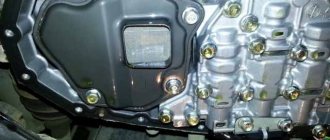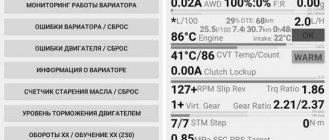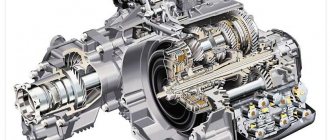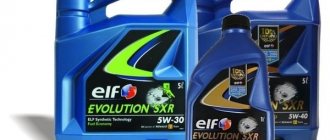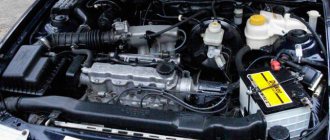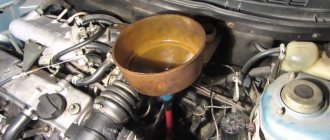The third generation of Outlanders appeared on the Russian market in 2012. And today, many of these cars already have a solid mileage. Moreover, the warranty period, during which the service is carried out in an official car service center, has ended for many cars.
Mitsubishi Outlander 3 tests
If the oil in the CVT gearbox has not been changed in the car before the end of the warranty service, then car owners often perform this operation on their own.
This is due to the relative ease of changing transmission oil in the Mitsubishi Outlander 3 variator, as well as the considerable cost of servicing the gearbox in a car service center.
In this article, we will consider the procedure for independently changing the oil in the variator of the third Outlander.
Brands of oils and their analogues, filling containers for the Mitsubishi Outlander 3 variator
It is important to pay special attention to the choice of lubricant for the Mitsubishi Outlander 3 variator. Mistakes in this matter can lead to deterioration of the mechanism and additional malfunctions
To avoid such consequences, it is important to buy only original oil from proven developers. Mitsubishi Dia Queen CVTF-J1 lubricant is poured at the Mitsubishi plant
Mitsubishi Dia Queen CVTF-J1 lubricant is poured at the Mitsubishi plant.
Subsequently, you can use an improved version of the composition for the variator - CVTF J4.
This brand of transmission fluid is indicated on the dipstick.
For a full range of activities, about 12 liters will be required (including washing)
But it is important to know that the filling volume of the CVT, according to the manual, is 5.5 liters. And after a major overhaul of the transmission it increases to 7.1 liters
But we will dwell on this issue in more detail.
4 liters of original transmission fluid, at the time of writing, will cost about 4,000 rubles.
To avoid falling for a fake, consider the following recommendations:
- buy oil for the Mitsubishi Outlander 3 variator only at official retail outlets;
- first study the product parameters on the official resource;
- compare the product information on the website and on the product box;
- look at the current levels of protection (color, seal, packaging, etc.).
If you have any doubts about the quality, it is better to refuse the deal, because the use of low-quality lubricant carries risks for the gearbox. It’s better to spend time choosing, but be sure of the quality.
To avoid mistakes, here are the article numbers of the main types of oil for Mitsubishi Outlander 3:
- Dia Queen CVTF-J1 - MZ313973 (1 l), S0001610 (4 l).
- Dia Queen CVTF-J4 - MZ320185 (1 L), MZ320261 (1 L, Genuine CVT Fluid Eco J4), MZ320262 (4 L, Genuine CVT Fluid Eco J4).
As an alternative, it is possible to use Nissan NS-2 series lubricants, which are also suitable for use in the Mitsubishi Outlander 3 variator. Here, focus on the following articles - 999MP-NS300P (1 l), KLE52-00004 (4 l).
As a last resort, it is allowed to purchase analogues of the following types:
- ELF ELFMATIC CVT.
- Pentosin CVT 1.
- MOPAR CVTF+4.
- AISIN CVT Fluid Excelent (art. CVTF7004, CVTF7020).
- IDEMITSU MULTI CVTF (art. 30301201-746, 30455013-520).
Taking into account the experience of car owners, the use of RAVENOL ATF NS2/J1 Fluid is not recommended due to the high risk of CVT failure. Many car owners complain about its quality.
Note that some of the lubricants discussed above are made at the same plant, so the main attention must be paid to cost and quality. To change the oil in the Outlander 3 variator, you will need additional items:
To change the oil in the Outlander 3 variator, you will need additional items:
- Mitsubishi upper filter with article number 2824A006 (a rubber gasket is included in the kit);
- pan filter with article number 2824A005;
- Mitsubishi drain plug gasket with article number 2705A013 (not necessary for the first replacement);
- Mitsubishi sealing gasket with article number 2920A096;
- Pan gasket 2705A015.
You will also need:
- open-end or socket wrenches 10 and 19 mm;
- container for draining old oil for 6-10 liters;
- liquid for washing the pan;
- watering can.
After preliminary preparation, you can start working.
Preliminary actions
Anyone can change the transmission fluid in the Mitsubishi Outlander 3 variator, the main thing is the desire to do it. In order to minimize inconvenience and not stop the process due to the lack of necessary tools, it is necessary to carry out preliminary preparations.
Necessary materials:
- Open-end wrench or socket wrench, size 19 mm;
- Open-end wrench or socket wrench, size 10 mm;
- Oil for gearbox, Mitsubishi CVTF-J4 brand (original), twelve liters;
- Intermediate seal for box tray 2705A015;
- Box crankcase gasket washer;
- A container where the old oil from the box will be drained;
- Means for flushing the variator;
- Watering can.
Necessity and frequency of replacement
The transmission fluid in the Mitsubishi Outlander CVT needs to be changed. The operation of the box is associated with conditions of increased loads. The task of lubrication is to minimize loads and make the wear process as small as possible.
Functions performed by the liquid:
- Elimination of overheating of parts and mechanisms of the box by removing excess heat;
- Elimination and removal of wear products formed in the box;
- Anti-corrosion protection of mechanisms and box parts;
- Filling voids at the junctions of box parts;
- Conversion and transmission of energy through the box;
- Creating a friction clutch in a box.
Correct performance of these functions leads to the fact that the lubricant ages and becomes unusable. Increased temperatures and friction forces are the main enemy of transmission fluid, which saturates the oil with wear products. An excess of particles turns the lubricant from an ally into an enemy of the box. Inclusions act as an abrasive, accelerating the wear process of the mechanism. Changing the oil in the Mitsubishi Outlander automatic transmission avoids negative impacts and extends the life of the variator.
The Japanese designers who developed the variator claim that the unit is capable of working out its design life without replacing the transmission fluid. This statement does not correspond to the realities of our region in which the vehicle is used. Experienced mechanics regularly change the oil in the Mitsubishi Outlander variator at least once every 80 thousand kilometers.
Brand and quantity of transmission fluid
Selecting transmission fluid for a box is a responsible process. The use of a lubricant of an unspecified type will greatly damage the mechanism and permanently disable it. Therefore, when purchasing oil for the Mitsubishi Outlander 3 variator, it is recommended to give preference only to original products.
The original fluid is in the box, a special oil, Mitsubishi CVTF-J4, developed by the company’s engineers specifically for the mechanism. A complete replacement will require the purchase of 12 liters of lubricant. It is recommended to purchase oil only from an official Mitsubishi representative. If there are no official dealers nearby, contact the company’s employees through the official website and, after familiarizing yourself with the features of oil packaging, order products through them.
Changing the oil in the Outlander variator
Moving on to the process of changing the oil in the variator, first set its current level. For this you can use a probe. For maximum accuracy of this indicator, it is necessary to warm up the machine to operating temperature (90 degrees). Taking out the dipstick, you will see three marks that form two intervals - these are “COLD” and “HOT”. So, the oil level on a warm car should be about 0, and after changing the fluid it should be at the same level. Carefully monitor the oil level in the variator - it should not be more or less, otherwise it will negatively affect the further operation of the box.
Stages of changing the oil in the Outlander variator
We will divide the entire procedure for replacing transmission fluid into several conventional stages, each of which consists of an alternate set of works.
Stage No. 1 - Drain the oil from the variator
- We drive the car to a special site for this kind of work - it can be a garage with a pit or an overpass.
- We measure the transmission fluid level using a dipstick.
- We remove the crankcase protection, or move it, unscrewing a couple of front bolts and loosening the rear ones, and wipe the variator crankcase with a rag prepared in advance.
- We fasten the watering can to the variator housing so that it is located in the place where the drain plug is located (to secure the watering can, you can use wire or rope);
- We begin to unscrew the drain plug, having previously placed a container for waste liquid under the watering can;
- When it’s hot, we drain the old oil from the box - this way it will come out to the maximum, and will also take away with it all the unwanted deposits that have accumulated in the box over 90 thousand kilometers.
- We determine the amount of drained transmission fluid - exactly the same amount of oil needs to be added.
- We wait about an hour until all the transmission fluid comes out of the variator (about 5.8 - 6 liters of waste should drain out).
Stage No. 2 - Flushing the variator
- As soon as the oil stops dripping from the box, you can screw the plug back in (don't forget about the washer).
- Now we move upstairs, take a clean watering can, and pour into it exactly the same amount of oil as we drained.
- Through the hole into which the dipstick is installed, carefully pour new transmission fluid. Check again that you have poured exactly the same amount of oil.
- Having finished filling the new transmission, we return the dipstick to its place and get behind the wheel.
- We start the engine and wait a couple of minutes, after which we smoothly, without jerking, shift all gears one by one, the delay between shifts should be approximately 30 seconds. We repeat this action about ten times. This procedure is necessary in order to mix the remnants of the old lubricant with the new oil.
- After that, we turn off the engine and return under the car. We substitute a container to drain the used fluid and repeat the oil change procedure, usually the same amount is drained as the first time (5.8 - 6 liters).
- When all the liquid has drained, dismantle the variator housing by unscrewing the fastening bolts with a wrench or socket. When removing the crankcase, remember that there is still oil left and it is hot. Carefully drain any remaining oil from the crankcase. In total you will get about 6.2 - 6.3 liters of transmission fluid.
- Now carefully inspect the variator housing for wear products (metal shavings, carbon deposits, etc.). If they exist (and they definitely will), we proceed to cleaning the crankcase using special cleaning agents or acetone.
- It also wouldn’t hurt to inspect the components and assemblies of the variator itself for defects and obvious malfunctions. They shouldn't be in a normal box.
- After checking everything, remove the transmission fluid coarse filter and also clean it. We wait until it dries.
- While we wait, carefully remove the old crankcase gasket, using either a knife or a slotted screwdriver (Just first, of course, carry out troubleshooting and make sure that a replacement is really needed).
- We return the filter to its place, install the crankcase in place, first checking that all parts are in place after cleaning (for example, magnets).
- If the plug is twisted, return it to its place.
Stage No. 3 - Pour new oil into the variator
- We repeat the procedure for filling in new fluid (remember that you need to fill it in the same amount as you drained the last time).
- We start the engine and check the gear shift.
- We check the oil level in the variator using the dipstick and, if necessary, add little by little.
- We go down under the car and check for any leaks.
- After driving a little, we periodically check the oil level in the box (it should not disappear).
Work order
Before starting to work directly with the lubricant in the Mitsubishi Outlander box, we determine the level. It is advisable to perform the procedure after the box has warmed up (temperature of the working fluid is 90°C), using a special probe with which the unit is equipped. Having removed the probe from the holder, special marks are applied to the surface: “Cold” and “Hot”. On a properly operating, warmed-up unit, the value corresponds to the “Hot” label. The level of the new fluid is brought to the initial value.
Important! It is extremely important to maintain a constant, correct level of working fluid in the box. Changing the value, either upward or downward, leads to negative consequences for the operation of the unit.
Procedure:
Draining the working fluid from the box:
- We install the vehicle on a pit, overpass, lift;
- We measure and remember the initial value of the liquid in the box;
- We dismantle the device protecting the bottom of the box;
- We install a watering can to drain the waste from the box, lower the end of the watering can into a previously prepared container;
- Unscrew the drain plug of the box;
- We drain the waste from the box;
- We measure the drained amount of oil from the box, the volume corresponds to six liters;
Changing the Oil in the CVT of Mitsubishi Outlander 3
To ensure the operation of the box, high-quality lubricant must be used there. Below is an annotation on how to change the oil in a Mitsubishi Outlander variator and advice on the timing of this task.
How often does it need to change the oil?
Level control and required volume
- How to change oil in artisanal conditions?
- Consequences of untimely shift
- Video “Visual aid to changing lubricant”
First of all, let's look at the mileage at which car enthusiasts change the lubricant and filter in the Mitsubishi Outlander 2008, 2011, 2012, 2013 and 2014 model years.
The official instruction manual does not indicate when and how it is often necessary to change the fluid in the boxes.
The manufacturer does not foresee the change of consumable water; it is poured into the machine entirely for the service life of the vehicle. But this does not mean that the lubricant does not need to be changed.
The substance is changed when the following symptoms occur:
- when driving on smooth asphalt, slipping occurs from time to time;
- in the area of the gearbox selector in the cabin you can feel vibrations that appear from time to time or on a constant basis;
- Unusual sounds began to be heard from the box - grinding, noise;
- There are difficulties with shifting the gearshift lever.
Changing the oil in the variator Mitsubishi ACX 1.8 CVT 2010
Such signs can vary and manifest themselves differently in different cars; it all depends on the criteria and correct use of the box. Approximately, the need to change water for motorists appears after 100-150 thousand kilometers. In order to prevent problems in the work of the box, experts advise changing consumables every 90 thousand kilometers.
A unique product for Outlander CVTs
Only a unique product should be poured into the Mitsubishi Outlander. DIA QUEEN CVTF-J1 lubricant has been developed specifically for the variators of these cars. It is designed to work in JF011FE boxes, which are equipped with Outlanders. The manufacturer does not recommend using other oils.
Although probably car enthusiasts successfully fill the boxes of their cars with water produced by Motul. If you believe the car manufacturer, then the introduction of non-original and low-quality oils leads to malfunctions in the gearbox and complicates the maintenance or repair of the unit.
To check the lubricant level in the boxes, use the dipstick located in the gearbox. The location of the meter is indicated in the photo.
To diagnose the level, start the engine and warm it up to operating temperature. The oil will become less viscous and the inspection procedure will be clearer. Remove the dipstick from the variator.
It has two marks - HOT and COLD. On a warm engine, the lubricant may be at the NOT level.
Location of the dipstick for level control
Changing the lubricant is a relatively easy procedure. To complete it, you will benefit from 100% of the funds and do everything possible without the help of others.
Before your shift, prepare:
- wrenches 10 and 19, it is better to use socket wrenches;
- fresh oil for filling into the variator, about 12 liters will be needed;
- seal for installation on a pallet;
- a new washer for installation in the pallet plug if the ancient part is worn out or damaged;
- a cleaning agent for the pan, in order to remove wear products with its use, ordinary acetone or a special liquid is used;
- funnel;
- a stationery knife or a Phillips-head screwdriver;
- container where you will drain the old grease.
Oil level control
The level should be checked regularly, at least once a month. To do this, it is necessary to carry out the following work.
- Drive several kilometers in normal mode so that the transmission warms up to operating temperature (70 - 80 degrees Celsius).
- Place the car on a level, non-sloping platform.
- By pressing the brake pedal, you should move the gearshift lever through all positions, holding it in each position for several seconds. The lubricant must reach all components of the hydraulic system.
- Set the selector to the “N” position – neutral, leaving the engine to rotate at idle speed.
- Put the car on the handbrake.
- Remove the dipstick, having first cleaned it of dirt using a clean rag.
- Assess the lubricant level and quality using the dipstick.
The oil level must be within o. If it is lower, add lubricant through the dipstick channel. If the level is exceeded, it is necessary to drain the excess amount of lubricant through the plug located in the lower part of the automatic transmission housing.
What is needed for replacement
According to the passport, the total amount of oil in the Mitsubishi Outlander variator is 7.3 liters. However, replacement will require about 5 liters. A complete replacement on this box is a rather labor-intensive operation.
Therefore, the vast majority of car enthusiasts practice partial. Moreover, in this case the oil is renewed by almost 70%.
For replacement, it is recommended to purchase original oil from Mitsubishi CVT Fluid J4 or its equivalent. When using analogues after replacement, you must be extremely attentive to the operation of the variator.
If any malfunctions occur in the operation of the CVT box, you should replace the oil with the original one as soon as possible. However, with the right selection, this happens extremely rarely.
Filter 2824A008
The fine filter must be changed. It is located in the heat exchanger housing. On the restyled Outlander model, the location of the filter is slightly changed: here it is installed in a separate housing mounted on the engine crankcase.
Additionally, you need to purchase a copper gasket for the drain plug and a box housing gasket. If the replacement is made for the third or fourth time, it is advisable to replace the sealing ring of the fine oil filter housing and the coarse filter.
Step-by-step ATF replacement
Choosing a lubricant is the first and very important step
The stores offer a wide range of lubricants. Where to stop? There is only one criterion here: only original products! No savings! No cheap analogues or fakes! A counterfeit product will seriously damage the box. At best, a secondary replacement of the substance will be required; at worst, repairs will be required. In the XL crossover variator, the lubrication function is performed by DIA QUEEN CVTF-J1 ATF. DIA QUEEN-J3 fluid is suitable for a 6-speed automatic transmission. A complete update will require 12 liters of lubricant.
Motors and gearboxes installed on Mitsubishi Outlander
The first generation car was equipped with two gasoline engines of 2.0 and 2.4 liters, and in 2004 a car with a turbocharged 2-liter engine with a power of 202 liters was released. With.
From 2005 to 2012, the second generation Mitsubishi Outlander was produced with a 2.0-liter manual transmission engine and a CVT, as well as a 2.4-liter power unit with a CVT only. As for the most powerful 3-liter version with 223 hp. s., it was equipped with a 6-speed automatic transmission.
In 2012, the third generation Mitsubishi Outlander was introduced, but sales began only at the end of 2013.
In 2014, the car underwent a restyling, in which the appearance and a number of technical components changed.
The car is offered in three engine options: 2.0, 2.4 and 3.0 liters with manual transmission, automatic transmission and CVT.
Namely:
- 2.0 4WD 4B11 146 hp
- 2.4 MIVEC 4B12 167 hp
- 3.0 4WD 6B31 230 hp
We will dwell on the option with a continuously variable transmission in more detail.
Resource and replacement time
Mitsubishi Outlander automatic transmission oil change
Talk that the lubricant used in the transmission is designed for the entire service life of the car should not be taken seriously. There are reasons for this. The lubricant may lose its properties due to:
- dirt or particles of wearing parts getting into it (most often these are small particles of gradually deteriorating clutches);
- due to prolonged operation of the automatic transmission under high loads;
- due to overheating of the transmission, which also occurs as a result of engine overheating.
Taking into account Russian operating conditions, the oil change in the Mitsubishi Outlander automatic transmission should be done once every 60 - 80 thousand km. mileage Thus, it is possible to significantly increase the resource and improve the operation of the node. In cases where the lubricant smells burnt or contains foreign matter, maintenance should be performed immediately. Remember that automatic transmissions are designed for a relaxed driving style. Sharp starts from a standstill and rapid acceleration are disastrous for them.
Oil selection
Owners of an early Mitsubishi Outlander should not have any problems choosing and purchasing the appropriate transmission fluid. The original uses ATF Mitsubishi Diamond SP III , but products from any manufacturer that meet the requirements of SP III . My only wish (but not requirement) is not to mix fluids from different manufacturers.
Starting in 2007, Outlander began to be equipped with the next generation of automatic transmissions, in which it is recommended to use Diaqueen ATF-J2 lubricant (in cases where the car has a conventional automatic transmission) and Diaqueen ATF-J1 in cars equipped with CVTs. And in this case, do not panic. These are just transmission fluids that meet the requirements of the ATF-J2 and ATF-J1 specifications. You just need to find products from a trusted manufacturer. It could be Motul, Ravenol or another company.
Let's determine the volume of oil required for a complete change in the Mitsubishi Outlander automatic transmission:
- on cars manufactured before 2007 (ATF Mitsubishi Diamond SP III) with front-wheel drive, the automatic transmission housing holds 7.7 liters of fluid, and with all-wheel drive - 8.1 liters;
- for models produced in 2007 and later, the crankcase capacity is 5.5 liters Diaqueen ATF-J2 for automatic transmission or 6.0 liters Diaqueen ATF-J1 for CVT.
Since replacement is carried out using the sequential lubricant replacement method, it is necessary to purchase double the amount of lubricant. Accordingly, 15.4 or 16.2 ATF Mitsubishi Diamond SP III, 11 liters Diaqueen ATF-J2 or 12 liters Diaqueen ATF-J1 . Better - even more.
What is oil degradation and how to reset the meter
In the Mitsubishi Outlander 3 ECU with a CVT there is a so-called oil degradation counter. The official name is CVT oil degradation level. When calculating the parameter, only the temperature of the lubricant in the gearbox is taken into account.
During operation, the counter awards points according to the following principle:
- t, C less than 90 - no points;
- t, C between 90 and 99 - 1 point/min;
- t, C from 100 to 109 - 2 points/min;
- t, C from 110 to 119 - 4 points/min;
- t, C from 120 to 139 - 6 points/min;
- t, C from 140 and above - 8 points/min.
As soon as the temperature reaches 138 C, system information appears about gearbox overheating. If this parameter increases to 149 C, the variator operates in emergency mode.
This counter is intended only to inform the driver and does not send any commands to other elements of the car.
Information from the degradation counter can be obtained using a MUT-3 scanner or other similar devices. As an option, it is possible to use the ELM 327 diagnostic adapter with Android software such as hobDrive, Torque Pro or cvtz50.
When changing the oil in the variator, it is not necessary to reset the counter. It is advisable to do this according to the manufacturer’s recommendation, so service station specialists do not skip this manipulation. You can do the reset yourself using the cvtz50 software.
POPULAR WITH READERS: Changing the oil in the 2.5 Nissan Teana J32 engine
You can analyze the meter parameters by comparing the received data with the information on the odometer. After pouring new lubricant into the Mitsubishi Outlander 3 variator, we take the odometer data as zero.
Next we do the following analysis:
The information from the degradation counter is three or more times less than the number on the odometer. Mitsubishi Outlander 3 CVT gearbox is in good condition. The temperature is normal. There were no overheats. The parameters of the degradation counter and odometer differ by less than 1/3 or are almost equal. This indicates frequent overheating of the gearbox. It is recommended to change the oil and at first monitor the temperature of the variator using any of the software mentioned above. The number on the degradation counter is greater than the data from the odometer. This indicates severe overheating of the transmission
It is important to contact specialists as soon as possible to resolve the problem.
Many car owners have a “0” on their degradation meter. This is normal, because if there is no overheating above 90 degrees Celsius, points are not awarded.
The likelihood of overheating is very low, thanks to the presence of a radiator, so the lubricant rarely heats up above 85 degrees Celsius. Older versions of the Mitsibisi Outlander (before CVT8) had an old type of radiator that did not do its job very well.
Judging by the information from the CVTz50 program, the oil temperature in the variator in summer and winter is in the range from 50 to 85 degrees Celsius (average).
To reset the grease degradation counter in the Mitsubishi Outlander 3, you will need:
- CVTz50 software;
- WiFi/Bluetooth adapter ELM327 bluetooth V4.
The CVTz50 program is paid and costs about 150 rubles.
Its capabilities:
- reading and resetting errors of the variator box and power unit;
- studying and setting the oil wear counter to zero;
- adjustment of XX speed and leading angle;
- control of transmission operation data;
- indication of temperature statistics (per month).
To reset the degradation counter on the Mitsubishi Outlander 3, do the following:
- Install the latest version of CVTz50 from Google Play.
- Install diagnostic connector adapter ELM
- Wait for it to be detected by Bluetooth or Wi-Fi (depending on the type).
- Start your device and check the connection. To do this, press the “Monitor” button of the variator operation.
If everything is done correctly, a log of information exchange between the adapter and the program appears on the display.
Next, find the oil degradation point and reset it to zero.
If desired, you can reset the data using MUT-3.
To do this, take the following steps:
- Turn off the ignition (key position in the lock - Lock).
- Connect MUT –III to the OBD diagnostic connector.
- Turn on the ignition (key position - ON).
- Use the special MUT-III option to reset. Go to CVT oil degradation level, and then to Clear CVT oil degradation level and click Clear.
- Turn off the car ignition (Lock position).
What else will you need to buy?
You should purchase a rubber seal for the pan, a special washer for the drain plug, and also a pan cleaner to remove waste oil residues. The substance LIQUI MOL serves this purpose. Those who want to save money can easily get by with acetone or kerosene.
Necessary tools and other means
- wrench heads for 10 and 19;
- slotted screwdriver or knife;
- two watering cans and containers for dirty oil (note that the container must hold 12 liters of liquid);
- clean cloth.
Armed with everything you need, you can begin practical actions. Changing the lubricant begins with checking its level.
Fresh product must be poured exactly to the mark set by the manufacturer. A lack of oil will cause the pump to take in air along with the lubricant. The consequences are the formation of an air-oil mixture and a decrease in pressure. The rubbing parts will not be properly lubricated, and the automatic transmission will begin to overheat. If there is excess liquid, it will foam and be released from the box through the breather. In both situations, the transmission will quickly fail.
So, the next step is to check the ATF level
The measurement is carried out with a dipstick while the engine is running and the lubricant temperature is 70˚. To warm up, they make a short trip (up to 15 km). There are three o's on the dipstick of an XL series vehicle, "Medium" and "Hot". The optimal oil level is “Hot”. By the way, during draining the liquid should also be hot: this way it will be removed faster and much less of its residue will “get stuck” in the variator.
Is it necessary to reset the counter?
Motorists who operate cars with CVT transmissions installed on them are naturally interested in one question. It concerns whether the counter needs to be reset.
The answer here is clear. On vehicles with CVT, zeroing is a mandatory procedure. If you are serviced by an authorized dealer, the specialists themselves will be able to reset the sensor and begin a new aging count. Performing a reset yourself is more difficult.
Many service books state that it is necessary to reset the oil aging sensor in the box. There are 2 main reasons why this is done:
- This information makes it clear in what mode the car and the variator itself are operated. That is, specialists and ordinary motorists can find out if there are problems with the CVT after its last reset.
- If you remove the oil aging sensor on the variator after replacing it, this makes it easier to determine the next replacement date in the future.
- On some cars, if you do not reset the parameters, the meter will cause an error to appear when connecting specialized diagnostic equipment.
From the position of a car owner, he does not really need such information. But this is a good way to find out the details of the operation of a car with a CVT when buying a car on the secondary market.
The presence of errors when connecting a diagnostic device or a large number of points over a short period of operation allows us to naturally assume that the variator was operated in very difficult conditions, and therefore quite serious problems may arise with it in the near future. The buyer would rather refuse to buy such a car.
Alas, CVTs are still far from perfect. These are the most vulnerable and delicate gearboxes, very susceptible to stress. The delicacy of CVT forces buyers in the secondary market to be extremely careful when purchasing used cars with a CVT.
Only after making sure that the variator was not loaded and was operating normally can you agree to the deal. An oil aging meter will provide significant assistance in this matter.
How to keep the gearbox working?
Replacing lubricant in a crossover automatic transmission is not regulated by the manufacturer. But practical experience suggests: when the car’s mileage exceeds 60 thousand km, the oil in the gearbox becomes clogged with wear microparticles, thickens and stops circulating fully, lubricating parts rubbing against each other. All this inevitably leads to automatic transmission breakdown and expensive repairs.
The cost of repairing a Mitsubishi Outlander XL gearbox can exceed 100 thousand rubles. A timely change of transmission oil, which the driver can do with his own hands, will protect you from major financial losses.
A little more about the timing. If the XL is used for driving on a highway with high-quality surfaces, the lubricant can be changed after 90–100 thousand km, but when operating the vehicle in unfavorable conditions, the procedure is carried out every 50–60 thousand km. Regardless of the mileage, fluid replacement is required even when alarm “signals” appear from the car.
What should you be wary of?
- You have to apply force when changing gears.
- An incomprehensible noise and grinding noise occurs in the automatic transmission, periodic or constant vibrations are observed.
- The “Iron Horse” slips not only in slush and snow, but also on dry asphalt.
- The vehicle's traction power weakens.
How to drain oil from a variator?
- First you need to drive the car onto a lift or into a pit;
- Using a dipstick, we measure the oil;
- you need to remove the crankcase protection, you can move it away, to do this you need to unscrew the front bolts and loosen the rear ones, then you need to wipe the gearbox housing with a rag;
- then you need to attach a watering can to the crankcase near the drain plug;
- You need to unscrew the drain plug, don’t forget to put a bucket for old oil.
The car has not yet had time to cool down, so as much oil as possible will leak out, and with it all the deposits. You can also see how much oil has leaked and the same amount will need to be refilled. Then you need to wait about an hour for all the oil to drain out. Approximately 6 liters of old oil will drain. There is approximately the same amount of oil in the CVT Passat B6.
Replacing waste material: sequence of actions
Attention! In the XL variator, the lubricant is replaced in two stages!
The ATF update in the 6-band automatic transmission is carried out according to the same scheme as in the continuously variable transmission of the XL crossover.
Instructions for the car enthusiast: principles of using transmission lubricant
Changing transmission oil yourself seems difficult only at first glance. Having carefully studied the recommendations of the masters outlined here, even a novice car enthusiast is able to carry out the procedure at the proper level and ensure impeccable performance of the vehicle’s gearbox.
